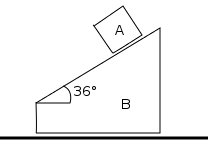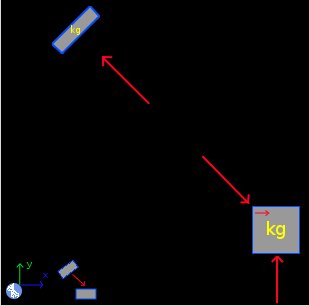Next: Example 9, Previous: Example 7, Up: Examples dynamics of particles [Contents][Index]
11.8 Example 8
A block A is above a block B, as show the image. Both blocks are in rest. If the block A have a mass of 1.7 kg, block B have 4 kg, and there isn’t friction, Which are the accelerations of the blocks when these leaves the rest? Which are the velocities after 0.2 seconds?

Solution with FisicaLab
Erase the content of the chalkboard and select the SI system. And add one element Stationary reference system, one element Block with horizontal movement, one element Block above an inclined plane to the left, and one element Relative motion. And add the necessary elements Force to make the free body diagram of each block. As show the image below:

To the element Stationary reference system, write:
- g
9.81
- t
0.2
To the element Block above an inclined plane to the left, the block A, write:
- Name
A
- m
1.7
- ang
36
- a
aA
- vi
0
- vf
vfA
- d
dA
- Relative to
B
Note that the movement of this block is relative to the block B. To its normal force:
- f
nA
- ang
54
To the element Block with horizontal movement, the block B, write:
- Name
B
- m
4
- a
aB
- vi
0
- vf
vfB
- d
dB
- Relative to
sf
To its normal force:
- f
nB
To the force applied to the block A:
- f
nA
- ang
54
The element Relative motion is necessary to get the acceleration, velocity and travelled distance of the block A, in reference to the stationary system. All these are unknown data, then write:
- Object
A
- asf
asfA
- ang_asf
ang_asfA
- vfsf
vfsfA
- ang_vfsf
ang_vfsfA
- dsf
dsfA
- ang_dsf
ang_dsfA
Now click in the icon Solve to get the answer:
nA = 11.765 N ; nB = 48.758 N ; aA = -7.165 m/s2 ; vfA = -1.433 m/s ; dA = -0.143 m ; aB = 1.729 m/s2 ; vfB = 0.346 m/s ; dB = 0.035 m ; asfA = 5.855 m/s2 ; ang_asfA = 225.994 degrees ; vfsfA = 1.171 m/s ; ang_vfsfA = 225.994 degrees ; dsfA = 0.117 m ; ang_dsfA = 225.994 degrees ; Status = success.